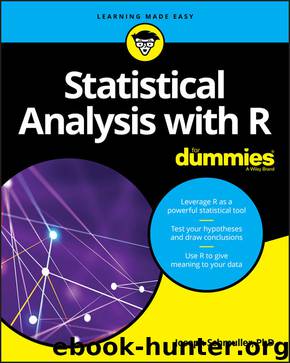Statistical Analysis with R For Dummies (For Dummies (ComputerTech)) by Joseph Schmuller

Author:Joseph Schmuller [Schmuller, Joseph]
Language: eng
Format: azw3, epub
ISBN: 9781119337263
Publisher: Wiley
Published: 2017-03-03T05:00:00+00:00
"z =", z.score,"\n",
"one-tailed probability =", one.tail.p,"\n",
"two-tailed probability =", 2*one.tail.p )}
t for Two
The example in the preceding section involves a situation you rarely encounter — known population variances. If you know a population’s variance, you’re likely to know the population mean. If you know the mean, you probably don’t have to perform hypothesis tests about it.
Not knowing the variances takes the central limit theorem out of play. This means that you can’t use the normal distribution as an approximation of the sampling distribution of the difference between means. Instead, you use the t-distribution, a family of distributions I introduce in Chapter 9 and apply to one-sample hypothesis testing in Chapter 10. The members of this family of distributions differ from one another in terms of a parameter called degrees of freedom (df). Think of df as the denominator of the variance estimate you use when you calculate a value of t as a test statistic. Another way to say “calculate a value of t as a test statistic” is “Perform a t-test.”
Unknown population variances lead to two possibilities for hypothesis testing. One possibility is that although the variances are unknown, you have reason to assume they’re equal. The other possibility is that you cannot assume they're equal. In the sections that follow, I discuss these possibilities.
Download
Statistical Analysis with R For Dummies (For Dummies (ComputerTech)) by Joseph Schmuller.epub
This site does not store any files on its server. We only index and link to content provided by other sites. Please contact the content providers to delete copyright contents if any and email us, we'll remove relevant links or contents immediately.
Sass and Compass in Action by Wynn Netherland Nathan Weizenbaum Chris Eppstein Brandon Mathis(7969)
Supercharging Productivity with Trello by Brittany Joiner(7328)
Mastering Tableau 2023 - Fourth Edition by Marleen Meier(7097)
Inkscape by Example by István Szép(6968)
Secrets of the JavaScript Ninja by John Resig Bear Bibeault(6739)
Visualize Complex Processes with Microsoft Visio by David J Parker & Šenaj Lelić(6650)
Build Stunning Real-time VFX with Unreal Engine 5 by Hrishikesh Andurlekar(5677)
Design Made Easy with Inkscape by Christopher Rogers(4999)
Customizing Microsoft Teams by Gopi Kondameda(4542)
Business Intelligence Career Master Plan by Eduardo Chavez & Danny Moncada(4441)
Extending Microsoft Power Apps with Power Apps Component Framework by Danish Naglekar(4151)
Salesforce Platform Enterprise Architecture - Fourth Edition by Andrew Fawcett(4014)
Linux Device Driver Development Cookbook by Rodolfo Giometti(4009)
Pandas Cookbook by Theodore Petrou(4007)
The Tableau Workshop by Sumit Gupta Sylvester Pinto Shweta Sankhe-Savale JC Gillet and Kenneth Michael Cherven(3818)
Exploring Microsoft Excel's Hidden Treasures by David Ringstrom(3293)
TCP IP by Todd Lammle(3118)
Applied Predictive Modeling by Max Kuhn & Kjell Johnson(3006)
Drawing Shortcuts: Developing Quick Drawing Skills Using Today's Technology by Leggitt Jim(2975)
